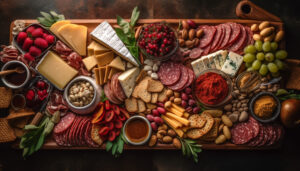Charcuterie Boards
Have you noticed the emergence of "Charcuterie boards" over the last couple of years? These meat and cheese trays, which have grown in popularity partly due to a growing trend on Instagram, typically feature mindfully placed slices of processed meats, cheeses, a spattering of nuts/olives/pickled vegetables, and perhaps a bit of fruit.
But the stars of the show are definitely the processed meats and cheeses.
What IS Processed Meat?
Processed meat refers to meat that has been transformed through salting, curing, fermenting, smoking, or other processes to enhance the flavor or improve preservation. Most processed meats contain pork or beef, but processed meats may also contain other red meats, poultry, or meat by-products such as blood.
Examples of cured/smoked/processed meats typically featured on a Charcuterie board include salami, sausage, bacon, pepperoni, chorizo, prosciutto and other varieties of pork. Hard cheeses such as cheddar, parmesan, gouda, and soft cheese such as brie, goat cheese, cream cheese, mozzarella, ricotta, and blue cheese are also sometimes offered.
I know that many of you LOVE these types of food, and may be very disinterested in hearing the negative health consequences associated with it. I get it....
... I was there too.
At one time in my life I was a huge fan of processed meats and cheeses too, and wasn't concerned one bit about how they could adversely affect me in the future.
With my dire family history, I shudder to think where my health would be today if I hadn't stumbled upon this information many years ago and changed my way of eating.
I was headed for big problems, that's for sure. I already had high cholesterol, declining bone health, and suffered one winter sickness after another every single year.
That's why I feel strongly that you need to KNOW these facts too, because how else can you make informed decisions about your food choices and health if you don't have all the information?
So for anyone who is concerned about their health and/or weight status, let me share just 5 reasons to steer clear of these foods (there are dozens of reasons I could list, but hopefully these 5 will be enough to convince you).
Reason #1: Heart Disease and Stroke
Atherosclerosis refers to the fatty buildup in the inner lining of our arteries, and that fatty buildup is called PLAQUE.
What are these plaques made of? Saturated fat, cholesterol, calcium, and other substances found in the blood.
The meats and cheeses served on Charcuterie boards are LOADED with saturated fat and cholesterol.
Saturated fat refers to fat molecules which have become covered with hydrogen atoms (they're saturated with them). The more saturated fats are with hydrogen atoms, the higher the melting point; so at room temperature, saturated fat stays solid (think lard and cheese).
Cheese is the the highest source of saturated fat in the American diet; other dairy products high in saturated fat include butter, ice cream, and milk. But meats and processed meats ar also quite high in saturated fat and rank as a close second. Saturated fat is visible. You can see it in the white marbling in bacon and steaks.
Cholesterol, on the other hand, is invisible. It's hidden in the animal's cell membranes, so we can't see it. Cholesterol is ONLY FOUND IN ANIMAL FOODS. There is zero cholesterol in plant-based foods.
Although eggs are the highest source of cholesterol (gram for gram, at least 8x more cholesterol than beef), the processed meats and cheeses being served on Charcuterie boards are very high sources as well.
So ask yourself....are these foods really worth atherosclerosis (the formation of plaques) that block your arteries and lead to heart attacks, strokes, Peripheral Artery Disease, and kidney disease?
Heart disease remains our #1 killer, claiming over 659,000 lives in the U.S. each year. The CDC reports that 805,000 people have a heart attack annually (striking one person every 39 seconds).
Reason #2: Cancer
A few years ago, the World Health Organization (WHO) released a report which classified processed meats as “carcinogenic to humans.” Processed meats rank as "category 1" - the highest of five possible cancer-causing categories – the same classification where we find asbestos, arsenic, and cigarettes.
Our own Cancer Institute agrees:
The American Institute for Cancer Research (AICR) had this to say in their official statement: “AICR strongly supports the (WHO’s) report classifying red and processed meats as carcinogens, and we hope it will spread the message that what we eat plays a role in cancer risk.
For years, AICR has been recommending that individuals reduce the amount of beef, pork, lamb and other red meats in their diets and avoid processed meats like bacon, sausage and hot dogs.”
The risk of cancer generally increases with the amount of meat consumed; an analysis of data from 10 studies estimated that “every 50 gram portion of processed meat eaten daily increases the risk of colorectal cancer by 18%” and that it also raised the risk of stomach and other cancers. For reference, 50 grams (1.8 oz) would equate to 2 slices of bacon, 2 slices of ham, 1 piece of smoked sausage, or about 1 hot dog.
Read more about this study in my article here.
We also know from Dr. T. Colin Campbell's work in The China Study, the most comprehensive study of lifestyle and disease every done with humans, that animal protein is a known carcinogen.
Think about how much of these foods are served every day: Breakfast sandwiches with ham, sausage or bacon; foot-long deli subs piled high with processed meats; pizzas covered with pepperoni, sausage, and salami; hot dogs are commonly served everywhere; brats can be purchased at the gas station; pre-packaged containers of lunch meat snacks; and packages of jerky which are available at most check-out counters.
Reason #3: Type 2 Diabetes
Contrary to popular belief, type 2 diabetes is NOT caused by sugar. Even the American Diabetes Association agrees with this statement on their website.
Type 2 diabetes is the result of too much FAT. Here's how it works. Glucose accumulates in our bloodstream because it cannot get where it needs to go - into our muscle cells.
Imagine each one of our cells having a door with a lock on it. Insulin is the hormone that unlocks the key to the door, so the glucose in the bloodstream can be escorted into the cells.
However, when the door locks get gummed up with fat, the cells become "insulin resistant." The insulin can no longer open the door, so the glucose remains in our bloodstream.
Meats, processed meats, and dairy/cheeses are VERY high in fat. Cheese, for example, is 70% fat. When we consider that our fat intake should be kept at 10%-15% of our calories, you can see why cheese/dairy/meats/processed meats are leading contributors to insulin resistance and a resulting diagnosis of diabetes.
Fortunately, this is reversible for those who are still producing enough insulin. Read more here.
Reason #4: Inflammation/Arthritis
Back in 2009, our top cancer researchers released a study called "The Dietary Inflammatory Index."
The goal was to evaluate the implications that chronic inflammation has in our major diseases. The index didn't rate individual foods per se, but rather it rated 45 different parameters of food.
Broadly speaking, the components of processed foods and animal products - such as saturated fats, trans fats and cholesterol - were found to be the highest pro-inflammatory components of food. (Refer to item #1 regarding the saturated fat and cholesterol on Charcuterie boards.)
In addition to making people feel achy and lethargic, the researchers reported that highly inflammatory foods equate to "lower function of the kidneys, lungs, and liver, and a higher risk of cardiovascular disease, impaired memory and mental health, type 2 diabetes, osteoporosis, arthritis, weight gain, and many types of cancer."
In fact, the researchers stated the a highly inflammatory diet increases our odds of getting cancer by 75%!
As you can see, even though arthritis is the ailment we typically associate with inflammation, inflammation is a BIG factor in almost every chronic ailment and disease we suffer.
If interested, I offer an entire class on the topic of inflammation; check it out here.
Reason #5: Gut Issues
Your gut microbiome is comprised of trillions of bacterial organisms that reside in your gastrointestinal tract. Most people think of bacteria as dirty or dangerous, but the vast majority of bacteria in our bodies are helpful, or at least not harmful.
A healthy gut microbiome assists with our nutrient absorption, regulates our immune system, prevents the growth of unfriendly organisms, and is crucial to good health.
Good bacteria can prevent (and heal) issues such as diarrhea, Ulcerative Colitis, Crohn's, and other GI disorders. Plus a healthy gut improves digestion, relieves constipation, and lessens symptoms of inflammation throughout the body.
However, problems occur when our microflora gets out of balance; in other words, the good bacteria get crowded out and the pathogens (bad bacteria) take over. The gut flora can become impaired by temperature, illness, antibiotics, and other drug treatments; but our DIETS play a huge role.
Friendly bacteria prefer to dine on plant-food remnants (fiber), while pathogens (harmful organisms) thrive when the diet is high in meat, dairy, and other junk foods - none of which contain fiber. Therefore, our food choices can determine which type of bacteria species will live in our gut.
Major alterations in the microflora take place within only one to two weeks of changing one's diet to a whole food, plant-based diet.
Summary
Charcuterie boards, in spite of their popularity and the businesses that have sprung up around them, are very detrimental to your health. There's just no two ways about it. If I may be so bold as to say, a Charcuterie board represents a tray of disease, being served up on a deceptive yet carefully arranged plate.
I know that's not a popular message, but I care enough about you to spell it out. I cringe when I see the people I care about gobbling down the very foods that are causing their ailments....some are unaware, and many choose to stay comfortably unaware.
The good news is you can make a HEALTHY Charcuterie board! One that won't clog your arteries, contribute to cancer and type 2 diabetes, one that won't inflame your joints or irritate your gut. One that you can feel GOOD about eating and serving!
For Healthy Charcuterie board ideas, click HERE and also HERE!
If you'd like more information about the healthiest way to eat, check out this free class: 3 Food Mistakes Which Lead to Painful Joints, Excess Weight, and Health Problems the Doctors Aren't Solving.
Also consider getting a copy of my book, The "Plan A" Diet," which includes a Transition Plan to help you get started.





